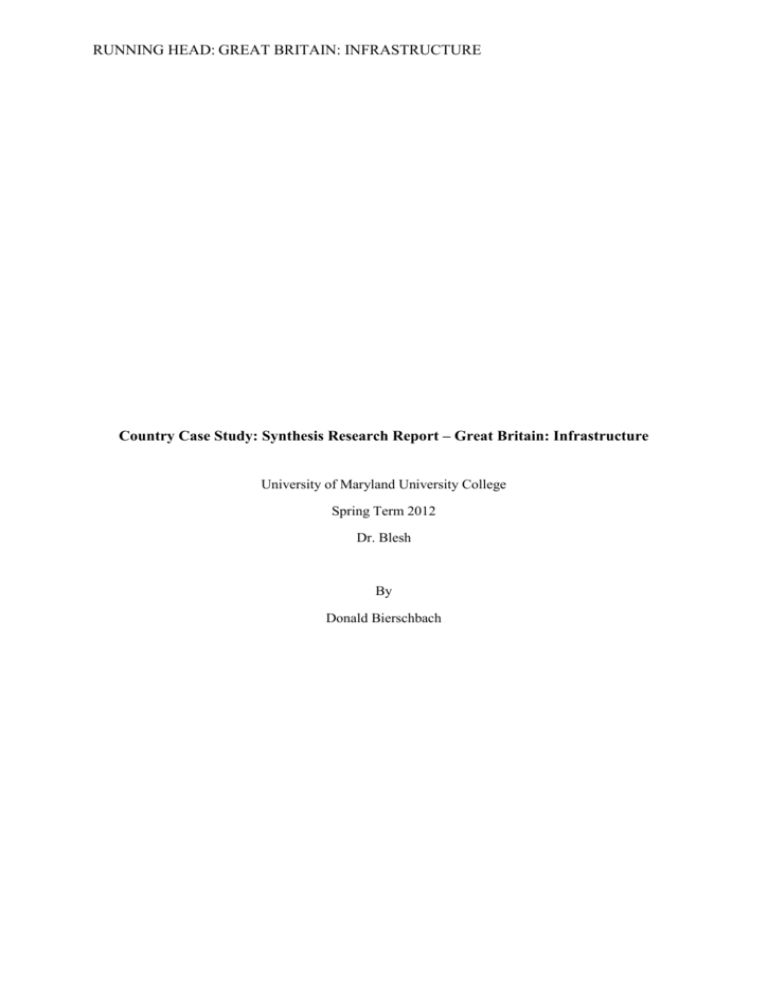
RUNNING HEAD: GREAT BRITAIN: INFRASTRUCTURE
Country Case Study: Synthesis Research Report – Great Britain: Infrastructure
University of Maryland University College
Spring Term 2012
Dr. Blesh
By
Donald Bierschbach
GREAT BRITAIN: INFRASTRUCTURE
2
In the increasingly inter-connected and inter-deepened world we live in we, interact
with so much technology that practically any aspect of society cannot be studied without
looking at the role technology plays.
Technology infrastructure is especially important within the borders of the British
education system. It has become a common thing that all the students of British educational
system have access the Internet anytime. Both elementary and secondary educational
institutions provide students with Internet access for a variety of different purposes, such as:
To have access to virtual libraries that provide with literature that cannot be bought
within the territory of Great Britain.
To participate in different conferences.
To find material for writing papers (for example, term papers, and others).
A major stumbling block for internet access in Great Britain is the cost. Access in
Great Britain is significantly higher than in most other developed countries. Great Britain,
does however have a well-developed Internet infrastructure which allows the state to provide
Internet access within the borders of educational institutions. Many countries cannot or won’t
provide this same support which is invaluable in todays’ technologically dependent world.
“Circuits of comparable size are often used to carry Internet access to the home in
Europe and North America. They can be had for 40 pounds a month in the UK. A
circuit of this size in many parts of Africa costs $100.00 a month” (Greaves, 2005, p.
1).
Teachers believe that it is their direct responsibility to teach children to work with the
help of Internet. They believe that Internet access has a direct impact on their educational
level and on their grade. The representatives of education in Great Britain realize that they
should start preparing their students for their future work from childhood, so that students
know how to work and cope with modern technologies in the future. They realize that a
GREAT BRITAIN: INFRASTRUCTURE
3
meaningful and well-paid job demands the skills and experience of working with modern
technologies.
It appears that modern technologies provoke greater interest in learning. It is more
interesting to access Internet and find all the necessary information there, rather than go to the
library and spend a lot of time there in search of the needed material.
“…once there is sufficient hardware in place, the IT department’s public goods are
readily over used. The library, moreover, distributes its goods in relatively lumpy
form: typically, books or journals” (Greaves, 2005, p. 1).
Some parents in Great Britain claim that they worry for their children because they
spend a lot of time online. However, the representatives of the British education system
guarantee total security and safety to children who are involved in some activities within the
frame of Internet. There are a number of organizations that are responsible for students’
security online. They are the following ones: 1. ScamWatch. It protects people from different
kinds of possible crime. For example, if a student has ordered a book and paid money for it,
the organization makes sure that a student has received that book; 2. InterGov; 3. Identity
theft: What you can do; 4. International Child Safety Center. The representatives of Great
Britain are actively protected by these organizations, so each student feels protected when
works online.
The main components of education infrastructure, such as: hardware, software,
networking, and safety play an increasingly important role in the world of elementary and
secondary education. An interesting question arises: Should all these technologies be used
within the borders of elementary educational establishments? The fact that small children
make up the representatives of elementary education does not prove that these technologies
should not be implemented there. Most teachers have access to the Internet and they can look
there for interesting information needed for a particular lesson, because there is a lot of useful
GREAT BRITAIN: INFRASTRUCTURE
4
information on the Internet covering many different subjects. For example, networking
provides a teacher with the possibility of finding an interesting song, cartoon, video that
would contribute to better understanding of some information. It is a well known fact that
children of elementary schools perceive information much better if they can visualize
(cartoon, animation) as well as hear this information, for example. As a result, children get to
learn and have fun at the same time.
Information Security is also an important factor. One major security issue in Britain is
student information. Teachers are restricted from both accessing or inputting student
information from any computer or other device that is not connected to the main information
system within the educational institution they are employed by. For example teachers cannot
save or access student information remotely or on their personal computing or
communication devices. These safeguards provide additional levels of security and safety
that protects data. This also protects information saved on a laptop from an external access.
As a matter of fact, the only student information e stored on teacher issued equipment is
contact information. So teachers can direct inquires to the representative of a particular
educational activity or institution.
Hardware components include many different sub-components, such as hard-disks,
flash-drives, notebooks, desktops, printers, scanners and other materials. These are all
necessary if often overlooked components of infrastructure. These are important and provide
teachers and students with multiple ways to interact, modify, edit, create and publish
information. These technologies are rarely consistent from school to school or district to
district within Great Britain. The availability and reliability of Britain’s internet
infrastructure ensure that remote/ distance education is available to not only students who
choose this educational environment but also those students who have physical, or
developmental disabilities that require them to receive education remotely.
GREAT BRITAIN: INFRASTRUCTURE
5
Video conferencing, Wimba, Skype, and others provide the same level of education
that the brick and mortar schools provide.
Furthermore, these same technologies and
possibilities extend to secondary and higher education as well.
In Great Britain, as in the United States and elsewhere teachers create different
websites, so that they always keep in touch with students and with their parents. It is a wellknown fact that good communication and cooperation between teachers and parents has a
very good impact on the educational level of students.
“The purposes of these teacher websites are to connect home and school and foster
independent learning; with increased computer access for students, they will get more
use” (Devlin-Scherer, 2003, p. 1).
These sites are very useful both for the representatives of elementary and secondary
education, because a student can get there the main information concerning his / her home
task, achievements, aims of a particular subject, dates of control works, and so on and so
forth. Even if a student has missed a class for some reason, he/ she can visit the class site and
find out what material he / she has missed and has to learn. Students always like something
new and, as a result, they like different websites, because there is always a lot of interesting
information and children are eager to do some interesting tasks.
“Students enjoyed the links page because they got to do new activities. They asked for
additional sites” (Devlin-Scherer, 2003, p. 1).
More than that, teachers use different photos and pictures and other interactive
activities to make lessons come alive and to help students think logically and help develop
students’ creativity, fantasy, and imagination. From a psychological point of view, a person
perceives information better if he or she sees the object that is discussed. In my review of
teachers and art I found that teachers who used this method during Art lessons, found this
GREAT BRITAIN: INFRASTRUCTURE
6
method to be very effective and, as a result, a lot of teachers have adopted these methods and
procedures when developing lesson plans and student activities.
“Preservice teachers in other disciplines learned from the art majors and began to use
photographs or paintings to introduce a variety of lessons” (Devlin-Scherer, 2003, p.
1).
Hardware helps students of secondary educational establishments to keep all the
information on the computer. A teacher can share his / her materials, so that students can
review that information and discuss it during lessons, rather than listen to boring lectures. t.
If we compare the usage of modern technologies in elementary and secondary
education in Great Britain to the ones that are used in the United States, we find out that both
countries use these technologies on a very high level. However, not all elementary and
secondary education establishments in the United States are provided with the same level or
type of technology infrastructure/ support. The disparity within the United States is largely
based on socio-economic status and circumstances. For example Students living in the intercity of Philadelphia or Baltimore will not enjoy the same level of or access to technology as a
student in my school in Arlington Virginia. This is largely a result of the way that school
funding and infrastructure is allocated. States not the federal government are ultimately
responsible for education within their states. The federal Governments role does extend to
providing the basic technology infrastructure this role is left to the private sector and as a
result it is largely an issue of who is going to provide the funding to implement, install, and
upgrade, the technology infrastructure. Great Britain on the other hand ensures that all public
and private schools within the education establishment have the same basic infrastructure.
However, the growing trend in the United States to Virtual Schools and public education for
profit has started to change the education dynamic by providing students of public schools
GREAT BRITAIN: INFRASTRUCTURE
7
with modern technologies provided by sponsors which has helped to expand and modernize
the education infrastructure.
In conclusion, It appears that in the United States and Great Britain the Government
does its best to provide all the schools with education infrastructure. Both countries actively
uses such components of education infrastructure as: hardware, networking, software, and
safety. These technologies are very effective and produce good and productive results within
the elementary and secondary education establishments. These and other modern
technologies provide teachers, and administrators with the opportunities to communicate with
parents and students. Great Britain and the United States actively use modern technologies in
elementary and secondary education to enhance and further student learning, and
understanding as a Segway into creating students that are prepared to meet the challenges of
the 21st Century. More research is needed to fully understand and implement policies on
what, and how new technology infrastructure is needed and how to implement these new and
emerging technologies into the existing education establishment.
GREAT BRITAIN: INFRASTRUCTURE
8
References
Devlin-Scherer, Roberta. (2003). Using Technology Artfully. School Arts. 103(3).
COPYRIGHT 2003 Davis Publications, Inc.,; COPYRIGHT 2003 Gale Group.
Retrieved March 10, 2012 from
http://galenet.galegroup.com.ezproxy.umuc.edu/servlet/BCRC?srchtp=adv&c=1&ste=
31&tbst=tsVS&tab=2&aca=nwmg&bConts=2&RNN=A110314498&docNum=A110
314498&locID=umd_umuchttp://galenet.galegroup.com.ezproxy.umuc.edu/servlet/B
CRC?srchtp=adv&c=1&ste=31&tbst=tsVS&tab=2&aca=nwmg&bConts=2&RNN=A
110314498&docNum=A110314498&locID=umd_umuc
Greaves, Duncan. (2005). A Pedagogical and Economic Critique of Student Charges for
Internet Access. International Journal of Education and Development using
Information and Communication Technology. 1(2). 2005 University of the West
Indies. Provided by ProQuest LLC. All Rights Reserved.








